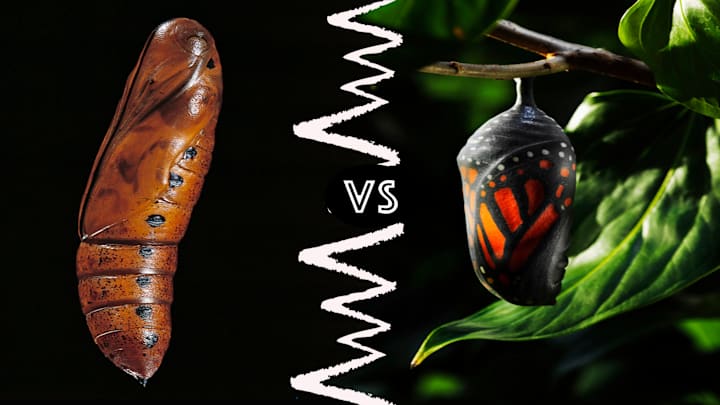When you hop out of bed after a long, restful nap, you may feel like a bug emerging from its cocoon. Or is the word chrysalis more accurate? And where does pupa fit in?
You may have heard these words being used interchangeably, but they don’t describe the same thing. If the lifecycles of insects come up in your regular conversations, it’s important to understand the differences between the terms.
Are Pupae and a Chrysalises the Same Thing?

According to the Australian Butterfly Sanctuary, pupa is a generic term for the part of the metamorphic process after the larval and before the adult phases of insect development. Bugs lose their larval structures and develop adult appendages during this stage of the cycle. You may be familiar with moth and butterfly pupae, but many other insects undergo such changes, including beetles, flies, ants, and wasps.
A chrysalis, on the other hand, is a type of pupa—specifically of a butterfly larva, which is commonly known as a caterpillar. It occurs between the larval and adult stages of a butterfly‘s metamorphic cycle. The chrysalis is essentially a hardened version of the larva‘s exoskeleton. Chrysalises normally camouflage with their surroundings for protection against predators.
Per the Florida Museum, some butterflies prepare themselves for pupation by spinning bits of silk into “buttons” and attaching their hind legs to them. The insects will then hang upside down in the shape of a J (or stand up straight, depending on the species) before hardening.
The main takeaway is that chrysalises are pupae, but not all pupae are chrysalises.
So What’s a Cocoon?
A cocoon is distinct from both a pupa and chrysalis. It is a hard, silk shell that a moth larva weaves around itself before it enters the pupa stage of metamorphosis.
Think of it as an extra layer of protection for the insect. One of the many differences between moths and butterflies is that the latter aren’t cocoon makers. Both, however, will hang from tree branches or the undersides of leaves as they develop into their adult forms.

Here’s a cheat sheet that might make the differences easier to digest:
Term | Definiton | Applies to |
|---|---|---|
Pupa | The general name for the life stage in which an insect transforms into an adult from the larval stage | All insects that go through metamorphosis |
Chrysalis | The name for a butterfly pupa | Butterflies only |
Cocoon | A silk case made to cover the pupa of a moth | Moths and some other insects, such as wasps and fleas |
Moths are generally less flashy than butterflies, but some of the prettiest ones may leave you speechless. You can marvel at them here.
Read More About Insects:
